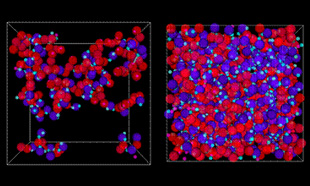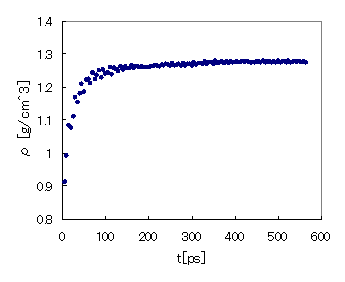- Full Atomistic MD
- Mechanical / Viscosity / Viscoelasticity
- Materials Science
Cross-Linked Structure of Thermosetting Resin
It may be possible to use a simplified chemical reaction model to create a complex three-dimensional network structure when using MD to study cross-linked structures of thermoset plastics. However, the molecular weight required for such a reaction process would be so large that it would require a long calculation time to relax the entire system structure.
It is therefore recommended to use Coarse Grained MD to create the cross-linked structure from the reaction process, and then apply reverse mapping to the full atomistic model after thoroughly relaxing the system [1].
To create the coarse grained model for the reverse mapping, it is necessary to generate a potential parameter value reflecting the molecular chemical properties. To solve this problem, we used the J-OCTA COGNAC modeler to obtain the Coarse Grained Potential of an epoxy monomer before and after a reaction along with a hardening agent. We then performed a reaction calculation using Coarse Grained MD to create a cross-linked structure of epoxy resin (Figure 1).
As shown in Figure 2, the density of a mixed system with the pre-reaction monomer plus the hardening agent was 0.91 [g/cm3]. After the reaction, the density increased to 1.28 [g/cm3].
We are currently working an easier method to apply reverse mapping to the full atomistic model.
 Figure 1. Epoxy Resin Cross Link Using the Coarse Grained Model
Figure 1. Epoxy Resin Cross Link Using the Coarse Grained Model
(Left) Image of single molecule during reaction, (Right) Reaction has progressed to a state in which the entire monomer has become a single molecule)
 Figure 2. Increase in Density Due to Cross Linking
Figure 2. Increase in Density Due to Cross Linking
- Reference
- [1] P. V. Komarov, C.Yu-Tsung, C. Shih-Ming, P. G. Khalatur and P. Reineker, Macromolecules, 40, 8104, (2007)


